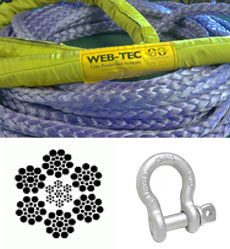Wires are constructed in different styles, weights, and sizes so that users have tools that meet their exact needs. The possibilities achieved with these vastly different ropes allow many businesses to thrive.
Your choices include:
Raw materials: although there are a variety of material options available, most wires are made from specified carbon steel. Carbon typically ranges from 0.4% to 1%. The manganese content ranges from 0.3% to 1%. In many cases, you will also find some levels of silicon, Sulphur, and phosphorus.
Manufacturing processes: during these processes, wire ropes begin to take shape. Raw materials are transformed into exact diameters and strengths. After, they are shaped by the process of drawing or rolling. Lastly, they can go through a cold forming process.
Wire rope accessories: using the right tools to aid material handling and other jobs, ensures maximum performance from your ropes. Consider veropes and nylon slings.
Wire surfaces: zinc-coated wires that have gone through liquid zinc are considered galvanized. If wires are considered finally galvanized, it means that they cannot get drawn further across the construction process. Drawn galvanized wire ropes have reduced wire cross-sections.
Wire forms: distinctions between types drastically alters behavior and performance capabilities. Wires with round cross-sections are considered round wires, whereas non-round cross-sections are considered profiled wire. Wires are created as ovals, flat, S-profiled, trapezoidal, and wedge.
Wire tensile strength: wires have different maximum tensile force, which means that depending on type and material, your rope will have a unique maximum breaking point.
Related Reading about Wire Rope
Wire ropes are suited for many different functions because they come in such a wide variety of sizes, construction, and material types. When shopping for wire ropes, the three most commonly used materials are Bright, Galvanized, and Stainless Steel.